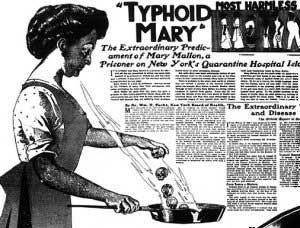Developing Food Safety Measures
Typhoid fever is a life-threatening, foodborne illness caused by bacteria of the Salmonella family - Salmonella typhi - that grow in the intestinal tract of an infected individual and are shed through the feces. Typhoid outbreaks had been occurring throughout the centuries, but it was not until the 1880s that the causative agent was identified. Soon thereafter, public health departments opened in major cities, and they were determined to use new scientific information to wipe out typhoid and other infectious diseases. Officials were given broad powers to investigate disease outbreaks and to quarantine infected individuals. This period happened to coincide with a large wave of immigrants coming to the United States. There was considerable prejudice against foreigners, many of whom were poor and forced to live in crowded, unsanitary conditions. The stage was set for finding unsuspecting immigrants on whom officials could lay the blame for disease outbreaks.
In the summer of 1906, several cases of typhoid broke out in the household of a wealthy family vacationing on Long Island. After lengthy investigation, suspicion focused on the cook who left her position about the time of the outbreak, Mary Mallon. The unwary woman was soon tracked down, leading to the meat fork encounter with the health official. Eventually, Mallon was taken into custody. Her feces samples indicated she was, indeed, a carrier of the typhoid bacteria.
She had evidently experienced such a mild case of typhoid that it went unrecognized, but she was unlucky to be among the small percentage of typhoid victims who continue to harbor the bacteria in their intestines. Despite her good health, Mary was quarantined by the health department and became the subject of a banner headline in a sensationalist newspaper of the day: “‘Typhoid Mary’ Most Harmless and Yet the Most Dangerous Woman in America.” After three years, Mary was released from quarantine but was returned when found to be working once again as a cook. She died after spending 26 years in captivity, at the age of 69.
 FIGURE 1.5 Mary Mallon, know as “Typhoid Mary,” was the first person identified as a healthy carrier of typhoid bacilli in the United States. She is pictured here while institutionalized on Brother Island, where she stayed from 1915 until her death in 1938.
FIGURE 1.5 Mary Mallon, know as “Typhoid Mary,” was the first person identified as a healthy carrier of typhoid bacilli in the United States. She is pictured here while institutionalized on Brother Island, where she stayed from 1915 until her death in 1938.
Mary Mallon (1869-1938) an Irish immigrant who cooked for wealthy New York families. She is history’s most famous super-spreader of disease.
Mary Mallon was first caught in 1906 when a sanitary engineer was hired to investigate a typhoid outbreak at Oyster Bay, Long Island. Six members of banker Charles Henry Warren’s household had fallen dangerously ill. Warren hired George Soper to discover the source of the contamination before the highly-contagious and deadly disease spread across the privileged enclave of Oyster Bay. (1) Oyster Bay was the site of Sagamore Hill, known as “the Summer White House” of President Theodore Roosevelt from 1902-1908.
###
Terry L. Smith
TERRY L. SMITH is a biostatistician and science writer who
lives in Lawrence, Kansas. She has an M.S. in biometry from the
University of Texas School of Public Health. Smith is the author of
numerous books and articles relating to human health, including
Asthma in Chelsea House’s Genes and Disease series.